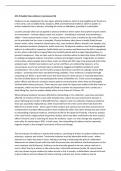AC1.3 Explain how evidence is processed. (6)
Evidence can be categorised into two types: physical evidence, which is any tangible proof found at a
crime scene, such as bodily fluids, weapons, DNA; and testimonial evidence, which is spoken or
written evidence from a witness, including the victim or defendant, provided it is admissible.
Locard's principle 1920 can be applied to physical evidence where states that anytime anyone enters
an environment – and two objects meet one another – something is removed, and something is
added - 'every contact leaves a trace'. In essence, every crime scene is worked on by crime officers
on the principle that the crime is traceable. Physical evidence takes forms in bodily fluids/tissues
(semen stains, saliva, footprints, blood stains, etc), trace evidence (fibres, threads, hair samples, etc)
and impression evidence (shoeprints, teeth marks etc). All physical evidence must be photographed
before it is collected for inspection. Bodily fluids such as semen and blood must be left to completely
air dry, where collected by scraping flakes and carefully placed within a paper bag polyethene, to
prevent transference. They are then sent to forensic scientists within an ideal time frame of 28 hours
to undergo serological analysis; of proteins, enzymes and antigens present. Fingerprints are dusted
onto by blue carbon powder where these marks are lifted with DCF tape to be preserved and further
analysed upon. Visible trace evidence such as hair and fibres are collected by tweezers, or by
vacuuming an area to be sectioned upon a laboratory, bagged and labelled carefully to avoid
contamination. This is then sent for further analysis by forensic scientists to undergo nuclear DNA
analysis – screening of the hairs and determining suitability. Trace evidence is analysed through
comparing soil, fibres or paint with traces that were found on their person or may help determine
the time of death based on how developed the larvae of blowflies are. Crime scene investigators,
police officers and forensic scientists require optimal communication where they are thoroughly
involved within these processes. There may be casts made for impression evidence like bite marks or
shoeprints, which are then electrostatically lifted to transfer the impressions from a surface to a
black lifting film, sent for analysis ideally within a time frame of 24 hours. 
Where physical evidence has been affected by mishandling or mis-collection, cases have also been
affected. An instance of this is seen with Amanda Knox, where she was sentenced to 26 years in
prison following the murder of Meridith Kercher, subject to the mis-collection of physical evidence.
Knox was separately implicated by a knife recovered from the crime scene which had shared the
DNA of her and the victim - where upon further analysis was said to have only been present due to
contamination as proper DNA procedures were violated by Italian CSIs. Barry George was also victim
to mishandling of physical evidence, sentenced to life for the death of Jill Dando. A forensic analysis
of his coat found a single particle of gunshot residue, which was later confirmed to be from a police
officer's firearm used in searching his house for evidence. Upon a re-trial, George was acquitted ,7
years after his sentencing in 2001. In both cases, the mishandling of evidence had an extremely
negative impact in the wrongful convictions of Knox and George.
The second type of evidence is testimonial evidence, consisting of written or spoken evidence from
witnesses, suspects and victims. Testimonial evidence must be admissible within court - where
relevant to a mater discussed in court, helping in proving or disproving the guilt of a defendant.
Statements are taken by each side from both the prosecution and defence and disclosed prior to the
court case (pre-trial disclosure). Evidence can be mutually agreed to be true, where read out in
court, rather than by a witness in the witness box. Vulnerable witnesses (under 18, special needs
etc) may choose to give evidence by video records or link in private, as defendants cannot be forced
to give evidence and are allowed to refuse entering a witness box. Some evidence may be




